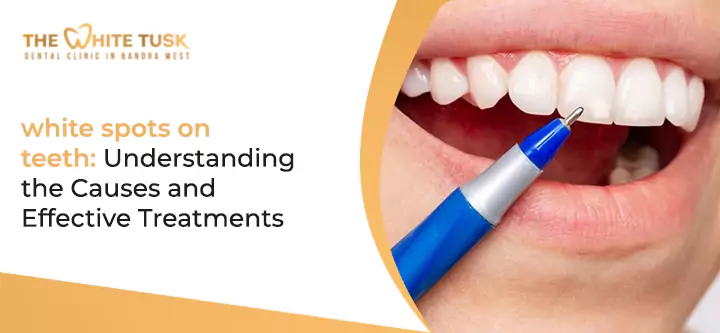
White spots on teeth can be a common concern for many individuals, affecting both children and adults. These marks, also known as hypomineralization or hypoplasia, can make your smile look less attractive and may indicate underlying dental health issues. Understanding the causes of white spots on teeth and exploring effective treatments is crucial for maintaining optimal oral health. Let’s explore this blog to gain insight into white spots.
Excessive fluoride intake, especially in children whose teeth are still developing, can lead to dental fluorosis. This condition is often characterized by white streaks or spots on the tooth enamel. While fluoride is essential for fighting cavities and strengthening enamel, too much of it can be detrimental.
The spots from fluorosis can range in appearance from barely noticeable white spots to prominent, discolored streaks or patches. These marks are permanent and may require cosmetic dental procedures to correct if they are a source of aesthetic concern for the individual.
Neglecting oral hygiene can cause the buildup of plaque, which can lead to white spots on teeth. These spots, known as decalcification spots, are early signs of tooth decay where minerals have been stripped from the enamel.
Plaque accumulation creates an acidic environment that weakens the enamel, resulting in these white lesions. To prevent these spots, regular brushing, flossing, and visits to the dentist for cleanings are essential.
Enamel hypoplasia is a defect of the enamel that occurs during tooth development. The enamel is thin and deficient in this condition, yielding white or yellowish spots on the teeth. The defects can be due to genetic factors, nutritional deficiencies, or environmental influences during enamel formation.
Teeth with enamel hypoplasia are more prone to decay and sensitivity and sometimes require dental treatments such as composite restorations or veneers for protection and aesthetic improvement.
Consumption of highly acidic foods and beverages such as citrus fruits, carbonated drinks, and vinegary foods can contribute to enamel erosion. Frequent exposure to acids can soften and wear away the enamel, often leading to the formation of white spots due to mineral loss.
To minimize the risk, it’s recommended to limit the intake of acidic products and to practice good oral hygiene.
Orthodontic appliances, such as braces, can make it challenging to maintain optimal oral hygiene. This can lead to white spot lesions around the brackets where plaque has accumulated and caused enamel demineralization.
These white spots are often more noticeable after the removal of orthodontic brackets, highlighting the areas where oral hygiene was insufficient. To prevent this, patients with braces are advised to clean meticulously around their brackets and may benefit from using specialized cleaning tools and dental products.
Recent studies have focused on developing innovative treatments for white spots on teeth, including nanotechnology-based solutions and enamel regeneration techniques. According to the American Academy of Cosmetic Dentistry, white spots on teeth affect approximately 20% of the population, highlighting the need for effective prevention and treatment strategies.
Dental technology continues to evolve, with advancements in laser therapy and digital imaging enhancing the diagnosis and treatment of white spots on teeth. Dental professionals are increasingly emphasizing the importance of patient education regarding oral hygiene practices and dietary habits to prevent white spot formation.
White spots on teeth can be a cosmetic concern and a sign of underlying dental issues. By understanding the causes and exploring effective treatments, individuals can maintain healthy and beautiful smiles. Stay informed about the latest news and statistics in dental care to make informed decisions about your oral health. Remember, prevention is key, so prioritize good oral hygiene practices and regular dental visits to keep your teeth free from white spots.